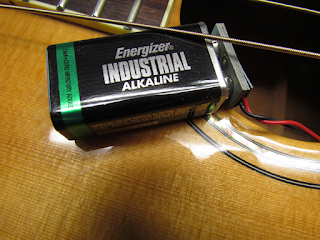First is the pickup. This guitar has an EMG undersaddle pickup with a preamp built into the endpin jack. When plugged in, it had no output.
I took a look inside the guitar and saw a battery bag attached to the side. At this point, I didn't realize there was a preamp - I just figured there was a pickup and no electronics.
I reached inside the guitar and opened the battery bag...
...and pulled out this Energizer 'Industrial Alkaline' 9v battery.
There was no date on the battery, and I figured (hoped) it was dead.
My beloved Fluke 87 DMM had stopped working a couple of months ago. Fortunately I also have a classic Simpson 260 on the electronics bench.
Measured the battery's voltage and found it was down to about 6 volts; I'd call that dead.
(Quick aside on my Fluke. I tried the usual check of the fuses and nothing. I wound up procuring a new Fluke 179 to replace it. Not quite an 87, but a lot cheaper and still plenty of meter for my needs).
With a new battery installed, the pickup came to life. Unfortunately, it had a bad hum. Clearly a ground issue.
I put my inspection mirrors inside the guitar and traced the pickup wiring, trying to find the preamp. You can see the wiring in the picture on the right, which I labelled.
In the last post on this guitar, I mentioned that someone online claimed this model had laminate sides and back. You can see clearly in this shot that the sides are indeed solid Koa.
After poking around inside and not seeing a preamp board, I figured it must be in the endpin/jack.
The strap button on the endpin doesn't screw on - instead, the whole assembly slides right out of the endpin hole. You can see the little round nubs that contact the end block and keep the jack from easily popping out.
The jack is in two halves which unscrew to access the preamp board.
It looked to me as if the ground tab on the pickup's shielded lead had come off the board. And sure enough, when I grounded the shield, the hum went away.
(Note the "EMG" on the board).
Rather than try and resolder the tab which came off the board, I decided to run a new ground lead from the shield to a ground on the board. You can see the blue lead I used. One end is wrapped around the shield, and the other lead is soldered to a tab that's shared with the battery's negative lead.
You may look at this and say "hey, why didn't you solder the ground onto the shield.
Good question! Originally, I did. And the guitar worked, but it now had an intermittent hum and signal drop out! What had happened is that the heat from the solder on the shield had partially melted the insulation on the pickup's hot side (white wire), shorting it out. It's a tiny wire, about 26 gauge. So on Round Two, I just tightly wrapped the ground wire around the shield, which is what you see above. I would have preferred to solder it, but the wrap is good and tight and won't come off.
One other note on the preamp is that there's a gain trimpot on one side of the board. It was set at about 1/4 volume, so I turned it up a touch to have a bit more gain. If you have this kind of preamp, you can experiment to find a good setting for decent output, but not too high as to make any taps or thumps on the body too loud.
In the process of sliding the preamp out, the clip holding the battery and pickup lead popped off. I just used some double-sided tape to put it back on. You don't want to leave any wiring hanging free where it can rattle against the body.
The second item is the pickguard.
My friend who belongs to the guitar wanted to take the clear pickguard off. You can see how it's developed a wrinkle over time and looks bad.
I heated it up a little with a heat gun on its lowest setting. Maybe 10 seconds at a time, just enough to help the adhesive loosen up.
I also made a little triangular tool out of pine to get under the edges and lift it up. The soft wood won't scratch the finish.
Eventually the whole pickguard comes off. It's pretty thin, unlike a typical plastic guard.
There was some adhesive residue left, so I put some thick Goo Gone on it, let it sit a few second and then worked it off.
The final step was to use Virtuoso cleaner and polish to polish the whole guitar.
You really need to make sure you clean the finish first, just like you would a car's paint, before you use any polish. Otherwise you're grinding any dirt into the finish, which just puts scratches into the finish.
For really filthy instruments, I'll use a weak mixture of Simple Green to get the nastiest stuff off. But this guitar is in such good shape, I just went to the cleaner first, then the polish.
It's so much fun to polish when the instrument is so beautiful!
Here's the spot where the pickguard was - looks great.
One more shot of the koa before I bid adieu to this guitar.
It's hard to photograph it, but there is a real 3D quality to the flame. From a couple of angles, it looks like there are ridges and peaks and valleys in the wood! Really fabulous.






















0 comments:
Post a Comment